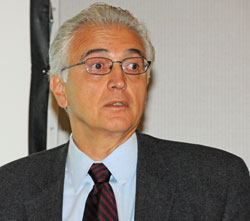One of the key messages of a Senate committee hearing on the Renewable Fuels Standard this week was that more research needs to be conducted before mid-level blends of more than 10 percent are approved.
 Margo Oge, the director of the Environmental Protection Agency’s office of transportation and air quality, submitted written testimony to the committee that said the agency is working with the Department of Energy (DOE) “to evaluate the impacts of the use of higher blends on the in-use fleet of highway vehicles and non-road equipment, and hope to complete the testing over the course of the next year.”
Margo Oge, the director of the Environmental Protection Agency’s office of transportation and air quality, submitted written testimony to the committee that said the agency is working with the Department of Energy (DOE) “to evaluate the impacts of the use of higher blends on the in-use fleet of highway vehicles and non-road equipment, and hope to complete the testing over the course of the next year.”
According to the testimony, EPA may consider a “conditional or partial” waiver of up to 15 percent ethanol in gasoline, which would restrict its use to only certain types of vehicles. “If a conditional waiver were granted, it may necessitate changes in the fueling infrastructure to accommodate different blend levels,” said Oge. “New pump labeling requirements or other measures may be needed to ensure consumers use the appropriate fuel for their vehicles and equipment.”
EPA does intend to seek comment on both the ethanol blend waiver request and the proposal to implement RFS2, “as expeditiously as possible.”
The hearing this week featured a panel of witnesses speaking from both sides of the issue, including representatives from the petroleum industry, the American Lung Association and the Natural Resources Defense Council who all called for more testing to be done before higher blends are approved for use. Opening statements from all witnesses, as well as video from the hearing itself is available on-line at the committee’s website.
After the hearing, Renewable Fuels Association president and CEO Bob Dinneen told USDA radio news, “I’m not smart enough to know if 20 percent is the right number, or 15 percent, but I darn well know that more than 10 percent can be used in vehicles all across the country today and it will help to stimulate more demand, more renewable fuel use and that’s exactly what we need today,” especially if the country is expected to meet the RFS.


 Ethanol demand, as calculated by the
Ethanol demand, as calculated by the  Earth Day 2009 is April 22, but Agland Cenex fueling stations in Greeley, Colorado will celebrate the day a bit early with their community on April 17. The sites at 1607 2nd Ave. and at 2449 35th Avenue will sell E85 for 85 cents per gallon from 10 a.m. until 2 p.m.
Earth Day 2009 is April 22, but Agland Cenex fueling stations in Greeley, Colorado will celebrate the day a bit early with their community on April 17. The sites at 1607 2nd Ave. and at 2449 35th Avenue will sell E85 for 85 cents per gallon from 10 a.m. until 2 p.m.  The first Earth Day was celebrated on April 22, 1970 with about 20 million people across America. Now Earth Day is celebrated annually around the globe. Through the combined efforts of the U.S. government, grassroots organizations, and environmentally caring citizens, what started as a day of national environmental recognition has evolved into a world-wide campaign to protect our global environment.
The first Earth Day was celebrated on April 22, 1970 with about 20 million people across America. Now Earth Day is celebrated annually around the globe. Through the combined efforts of the U.S. government, grassroots organizations, and environmentally caring citizens, what started as a day of national environmental recognition has evolved into a world-wide campaign to protect our global environment.  According to the
According to the The latest edition of Domestic Fuel Cast listens in on some of the conversation at this week’s Farm Foundation “Transition to a Bioeconomy: Global Trade and Policy Issues” conference.
The latest edition of Domestic Fuel Cast listens in on some of the conversation at this week’s Farm Foundation “Transition to a Bioeconomy: Global Trade and Policy Issues” conference. This is the fourth in a series of conferences looking at the transition to a bioeconomy the Farm Foundation has sponsored. This week’s event brought people from around the world to Washington, DC, where they were able to combine their divergent viewpoints to come up with workable solutions that everyone can live with. Unlike some other conferences where everyone already agrees before they meet, these Farm Foundation meetings put together people with vastly different perspectives. The conversations are lively, they’re maybe a bit pointed, but they work… and they are something we need to have more of in this country: frank, honest discussions where everyone doesn’t have to agree.
This is the fourth in a series of conferences looking at the transition to a bioeconomy the Farm Foundation has sponsored. This week’s event brought people from around the world to Washington, DC, where they were able to combine their divergent viewpoints to come up with workable solutions that everyone can live with. Unlike some other conferences where everyone already agrees before they meet, these Farm Foundation meetings put together people with vastly different perspectives. The conversations are lively, they’re maybe a bit pointed, but they work… and they are something we need to have more of in this country: frank, honest discussions where everyone doesn’t have to agree. College students work best under pressure – so here’s your deadline to enter and win a MacBook Air laptop in the
College students work best under pressure – so here’s your deadline to enter and win a MacBook Air laptop in the  Robert Friedland, President and CEO of
Robert Friedland, President and CEO of  Commercializing Gasification/Fermentation Technology was the topic of comments made by Mark Dietzen,
Commercializing Gasification/Fermentation Technology was the topic of comments made by Mark Dietzen,